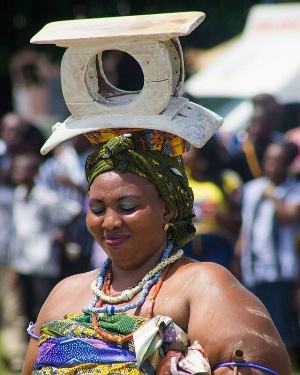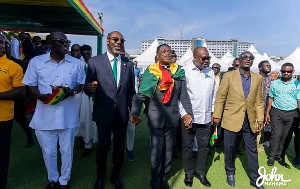Opinions of Tuesday, 8 August 2023
Columnist: Joel Degue
Hogbetsotso Festival: Celebrating the epic migration journey of the Ewe people
The Hogbetsotso Festival, the "Festival of the Exodus," traces its origins back to the 17th century. It was instituted and celebrated for the first time in 1962 by the Dogbo Ewes of the Southern Volta Region of Ghana generally referred to as Anlos, after their traditional capital, Anloga.
The Ewes are the largest of the four linguistic groups that constitute the Gbe ethnic group. Not all of them migrated into Ghana, as large sections of them are found in Togo, the Republic of Benin and in Lagos State, Nigeria. The other Gbe group members are the Ajas, Fons, the Ge-nyis and the Phla, Phera (or Egun) of Benin Republic.
Ewe folklore has it that the Dogbo Ewes embarked on an epic journey to escape oppressive rule in the walled city state of Notsié under King Agor Akorli, and found new homes in their present settlements in the Volta Region and southern Togo. The Hogbetsotsoza (Hogbeza) or Hogbetsotso Festival thus commemorates their epic journey to their final place of settlement.
Ewes generally trace their migration to all kinds of places but historian agreed that they sojourned in Nigeria for a long time before the expansion of and conflicts with the Yoruba people forced them to migrate to Ketu in present day Benin Republic. There, they lived in another walled town with another tribe of the Yorubas and the Ga-Adangbes who also migrated from Nigeria.
Subsequent pressure from the more numerically larger Yorubas from the Oyo Kingdom forced them to embark on another journey of migration, breaking into two groups known as Dogbo and Nyigbo.
Tado became the first major settlement they founded, followed by Notsié. It was thus from there that the Dogbos migrated before finally settling in Anlo, now in modern day Ghana. The festival thus serves as a testament to their resilience, quest for freedom, and triumph over adversity.
The Hogbetsotso Festival stands as a vibrant cultural celebration in Ghana, paying homage to the awe-inspiring migration journey undertaken by the Ewe people.
This annual festival, filled with colorful rituals, captivating performances, and a deep sense of heritage, serves as a powerful reminder of the rich history and resilience of the Ewe community.
This article explores the historical significance of the Hogbetsotso Festival, tracing the migration journey from Ketu through Tado to Notsié, culminating in the present day Anlo, and highlights the attractions that await visitors during this extraordinary celebration.
Festival highlights:
The Hogbetsotso Festival is a grand spectacle that combines vibrant parades, music, dance, and cultural displays spanning several days, attracting both locals and tourists alike. However, it begins with solemn rituals and town cleaning exercises (dordede) that begin months earlier. Here are some key highlights opened to the public:
School Children Hogbetsotso: This is the first grand public celebration. It is a unique part of the festival where school children from all schools in Anlo land gather at various central places to showcase Anlo culture in great display of drumming and dancing, regalia, dressing and other paraphernalia. These young Anlo children drum and dance in almost all drumming and dancing types in Anlo culture: Misego, Agbadza, Gahu, Kinka, Kpegisu, Gadzo, Attrikpi, Akpoka, Atsagbekor, etc.
Historical reenactment: The festival begins with a reenactment of the migration journey, showcasing the trials and tribulations they faced along the way. Dressed in traditional attire, participants dramatize significant moments of the journey, transporting spectators back in time.
Traditional processions: Colorful processions fill the streets, led by chiefs, priests, and priestesses adorned in regal attire. The rhythm of traditional drums and chants creates an enchanting atmosphere as the processions move through the community, invoking a sense of unity and pride.
Drumming and dancing: The festival pulsates with the energetic beats of indigenous drums and rhythmic dances. Spectators are captivated by the skillful drummers and agile dancers, who convey stories and emotions through their artistry.
Mini Hogbeza: A mini Hogbetsotsoza is now launched in one of the capitals of the Anlo Dukor or state.
Grand durbar: The grand durbar of chiefs and people of Anlo, with the Awoamefia sitting in state, is on the first Saturday of November in Anloga, the traditional capital.
Cultural tourism impact:
The Hogbetsotso Festival not only serves as a cultural celebration but also plays a crucial role in promoting cultural tourism in Ghana. Visitors who attend the festival have the opportunity to witness and engage with the rich traditions and customs of the Ewe people.
The festival offers a chance to learn about the Ewe's migration history, their ancestral beliefs, and their unique artistic expressions. The impact of cultural tourism extends beyond the festival itself. It supports local economies by creating opportunities for vendors, artisans, and hospitality services. Additionally, it fosters cross-cultural understanding and appreciation, promoting tolerance and unity among diverse communities, as chiefs from other ethnic groups are invited to grace the occasion.
Conclusion:
The Hogbetsotso Festival stands as a captivating cultural celebration that honors the extraordinary migration journey of the Ewe people. With its vibrant rituals, lively performances, and rich historical significance, the festival offers visitors a unique opportunity to immerse themselves in the diverse heritage of the Ewe community. By attending the Hogbetsotso Festival, travelers can gain a deeper appreciation for the Ewe people's resilience and cultural contributions while forging unforgettable memories of their own.











